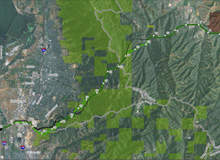
The Apex Expansion Project included the construction of 28 miles of 38in pipeline called the Wasatch Loop and other facilities in the Kern River interstate pipeline system. Owned and operated by Kern River Gas Transmission Company, the Kern River pipeline has been operational since 1992.
The $373m expansion increased the natural gas transmission capacity of the pipeline system by 266mmcf/d.
The Apex expansion was proposed in November 2009. Following an extensive environmental review, the Federal Energy Regulatory Commission approved the project in September 2010. Construction was completed in 2011 and the pipeline was placed into service in October 2011.
The Kern River system transports 2.14bcf of natural gas per day. It helps meet the increasing demand for natural gas in the region and improves the service reliability of Kern River’s gas transmission system.
Pipeline route
The Kern River’s pipeline system is looped from Wyoming to regions in Las Vegas and to San Bernardino in California. This provides a two-pipeline delivery system increasing transmission capacity.
The pipeline network passing through the Wasatch Mountains, however, is not looped limiting transmission capacity. The Wasatch Loop built as part of the Apex expansion has eliminated this bottleneck by passing through the Wasatch Mountains in the Morgan, Davis and Salt Lake counties of Utah.
Construction and infrastructure
In addition to the Wasatch Loop, a new compressor station was constructed at Milford in Beaver County, Utah. The compressor station features a turbine-driven compressor and other ancillary equipment.
The compression capacity of the compressor stations at Coyote Creek, Wyoming, Elberta, Utah and Dry Lake, Nevada, has been boosted. The Fillmore compressor station in Utah was upgraded with the installation of a new compressor, six mainline valves, three pig launchers and two pig receiver facilities.
Construction of the Wasatch Loop involved remote and difficult terrain. Approximately five miles of pipeline route consist of extremely steep terrain. The project included 20 creek crossings and 18 steep hill sections. Two horizontal directional drills and nine road bores were required.
A special retaining wall was built along with a speciality backfill when the pipeline passed over the Wasatch Fault. Certain areas of the pipeline route required helicopter delivery of workers, construction materials and fuel.
The pipeline’s construction was carried out in a 100ft-wide right of way. The pipeline was buried at a minimum depth of 3ft. All construction works such as clearing, digging, storage of subsoil and topsoil were done on the right of way.
Stages
The Apex Expansion Project was carried out in two phases. The first phase began in October 2010 and consisted of clearing, grading, removal of trees, bushes and other debris.
The east end of the pipeline in Morgan county and the west end of the pipeline in Salt Lake county were installed during phase I. Work on the compressor stations in Utah and Nevada was also carried out.
Most of the pipeline construction work was carried out during the second phase, which began in 2011. Works on the compressor stations in Utah and Wyoming were also carried out during this phase.
Contractors
The Wasatch Loop was engineered by Universal Ensco and built by Barnard Pipeline.
In September 2009, Gulf Interstate Engineering Company won a detailed engineering contract for the Milford compressor station and existing compression facilities of the project.
In August 2008, Kern River Gas Transmission Company signed a contract with NV Energy for long-term transportation of gas. As part of the contract NV Energy will receive 390mmcf/d of gas from the Kern River system. The agreement ensures that the increased capacity resulting from the Apex project is fully subscribed.



